|
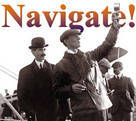
 Up
Up 
 Rebuilding
Rebuilding
a Reputation

(You are here.)
 Down
Down




  Need
to Need
to
find your
bearings?
Try
these
navigation aids:
If
this is your first
visit, please stop by:
Something
to share?
Please:



|
|
Available in Française, Español, Português, Deutsch, Россию,
中文,
日本, and others.
 n
30 June 1898 Walcott went back to the USGS full time.
Richard Rathbun, who had joined the Smithsonian in 1897 with
Walcott, became Assistant Secretary and head of the National Museum.
But with his offices in the National Museum Building, Walcott was
never very far away from the goings-on at the Smith. He shared in
the triumph when the new museum building was funded, then was
heart-broken when the Aerodrome failed to fly – twice. n
30 June 1898 Walcott went back to the USGS full time.
Richard Rathbun, who had joined the Smithsonian in 1897 with
Walcott, became Assistant Secretary and head of the National Museum.
But with his offices in the National Museum Building, Walcott was
never very far away from the goings-on at the Smith. He shared in
the triumph when the new museum building was funded, then was
heart-broken when the Aerodrome failed to fly – twice.
Langley made his
first attempt to launch the Aerodrome on 7 October 1903, flinging it
from the top of a houseboat with a giant catapult. The Aerodrome
left the catapult and traced a gentle arc to the surface of the
Potomac River. It showed no ambition to fly, it simply "slid into
the water like a handful of wet mortar" as one newspaper reported.
The second attempt on 8 December 1903 was much more spectacular, but
equally disappointing. As the Aerodrome left the catapult, the back
wings folded up, the tail crumpled and the aircraft turned almost
upside-down as it dropped into the river. Its pilot, Charles Manly,
was trapped beneath the wreckage in the icy water. He did not panic,
but kept his head and dove down and away from the sinking aircraft.
He surfaced yards away and was quickly plucked from the water by
workmen in a rowboat.
What caused
these failures is still a matter of debate, but the photos taken of
the Aerodrome during the launches clearly point to the wings. They
were just too flimsy. When traveling through the air at flight
speed, they could not hold their shape, angle of attack, or even
their horizontal position. The photos from the 7 October launch show
the forward wings are twisted so as to drive the nose of the
aircraft down. There aren’t as many photos to analyze of the 8
December attempt because the aircraft was launched late in the day
when the light was waning. But the one photo that does exist shows
the back wings folded up. The spars seem to have snapped at their
roots as the Aerodrome left the catapult and the wings took its full
weight. In both cases, the wings failed or deformed.
Langley laid the
blame elsewhere. After both launch attempts, he insisted the
Aerodrome was airworthy; the fault was in the launching mechanism.
It had caught on something as it was flung into the air. He pointed
out that this was an experiment; he was close to the solution, he
just needed more money to continue the tests until he licked the
launch problem. He had already applied for an additional $25,000 in
September 1903, but after the second failure, the Army declined. In
its final report on the Aerodrome project, the Army concluded, “we
are still far from the ultimate goal, and it would seem as if years
of constant work and study by experts, together with the expenditure
of thousands of dollars, would still be necessary before we can hope
to produce an apparatus of practical utility on these lines." They
deposited the remains of the Aerodrome at the Smithsonian in case
Langley wanted to continue the tests on his own dime. Privately,
several members of the Army said they would like to see further
tests.
Publically, the Army was much more
critical, as was Congress and the media. The Boston Herald
suggested Langley should give up airplanes and try submarines.
Representative Gilbert Hitchcock
of Nebraska commented to the Brooklyn Eagle, "You can tell
Langley for me ... that the only thing he ever made fly was
government money " Walcott was appalled as Langley was lampooned
again and again in the newspapers and on the floors of Congress, and
not just because his friend was under fire. These comments affected
Walcott’s respectability as well as Langley’s.
Samuel Pierpont
Langley died on 26 February 1906, leaving the Smithsonian with its
reputation at low ebb. Not only had it suffered the embarrassment of
the failed Aerodrome, there had been problems with the new building.
Work was halted in 1905 as its ornate baroque design was exchanged
for a simpler dome and columns. That same year, the Smithsonian’s
accountant W.W. Karr was found with his hands in the till. And
toward the end of the year, reports began to surface that a pair of
bicycle mechanics from Dayton, Ohio had developed a practical
airplane with no financial resources other than their own earnings.
When compared to the $50,000 Langley had spent – $73,000 if you
counted what he borrowed from internal Smithsonian funds – this was
a major political embarrassment.
The Board of
Regents first offered the Smithsonian’s reigns to Henry Fairfield
Osborn, another administrative genius whose innovative dinosaur
displays at the Museum of Natural History were drawing crowds. When
Osborn declined, they turned again to Charles Walcott, who this time
accepted the challenge and began to rebuild the Smithsonian’s
reputation. And part of his plan to do so was to rehabilitate
Langley’s reputation as a pioneer in the science of aeronautics.
In late 1909,
the Smithsonian instituted the “Samuel P. Langley Medal for
Aerodromics” to recognize recipients for contributions to knowledge
of aeronautics and aviation. The first Langley Medal would be
awarded to the Wright brothers whose reputation had achieved
rock-star status after their triumphant tour of Europe and
highly-publicized flights around New York City. Some members of the
award committee – among them the Wrights’ one-time supporter, Octave
Chanute – argued that the Wrights were too commercially-focused to
deserve the award. The patent infringement suits that they were
beginning to file were drawing attention. But Walcott knew he needed
to ride the Wrights’ considerable coat-tails to get Langley back in
the news and in a favorable light. President William Howard Taft
awarded the Langley Medal to Wilbur and Orville Wright on 19
February 1910. At the award banquet, Alexander Graham Bell gave a
long speech enumerating Langley’s achievements in aviation, barely
mentioning the Wright brothers. When he did mention them, he made it
seem as if the Wrights had built upon Langley’s work. The 1910
Smithsonian Annual Report, which published copies of these speeches,
compounded this misconception by misquoting Wilbur.
A month later,
the Smithsonian opened its new building across the Mall and began
moving its natural history collections to their new digs. The old
National Museum building became the Arts and Industries building,
and with the fossils gone there was suddenly enough room to display
some airplanes. Walcott planned to exhibit four Langley aerodromes,
including Aerodrome A. He wrote Wilbur Wright on March 7,
asking that the Wrights supply a Wright aircraft, or perhaps an
engine and some models. Wilbur countered by offering Walcott models
if he wanted them, but also telling him that the 1903 Wright Flyer –
the first airplane to make a sustained and controlled powered flight
– was available. Walcott responded on April 11, describing the
planned aviation exhibit in more detail. He seemed unimpressed with
the offer of the 1903 Flyer and more interested in displaying the
1909 Wright Military Flyer “…inasmuch as that machine used at Fort
Myer has attracted such world-wide interest…” The most telling
remark in his letter, however, was, “The natural plan would be to
install the different Wright machines along with the Langley
machines, making the exhibit illustrate two very important steps in
the history of the aeronautical art.” After their experience at the
Langley Medal ceremony, Wilbur and Orville could not help but think
that the exhibit, as described, would aggrandize Langley’s work at
the expense of theirs. Wilbur declined to reply and Walcott did not
persist. In the end, he represented the Wrights by procuring the
worn-out Signal Corps No. 1 from the Army. This was the
Military Flyer he had seemed so keen on in his letter.In
Their Own Words
-
Langley Memoir
on Mechanical Flight – Charles Manly, Langley's assistant on
the Aerodrome project, summarizes Langley's aeronautical
experiments and concludes that Aerodrome A only needs
further testing to prove that it was airworthy. Published in
1911, this was part of the Smithsonian campaign to rehabilitate
Langley's reputation. It's also an excellent overview of
Langley's work in aeronautics.
|
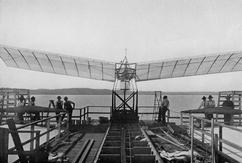
The Aerodrome A was built in
several sections -- frame, wings, and tail – then assembled in place
on its catapult.
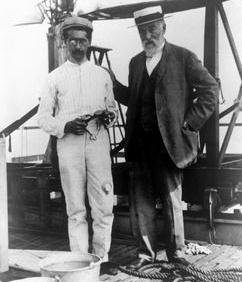
Samuel Langley (right) and the Aerodrome's chief engineer and pilot,
Charles Manly (left). Note that Manly has optimistically sewn a
barometer into the left leg of his trousers to gauge his altitude in
flight.
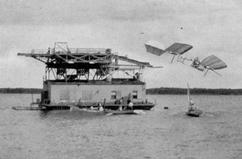
The Aerodrome is launched on 7 October 1903. Upon clearing the
catapult, it takes a shallow dive into the Potomac River.
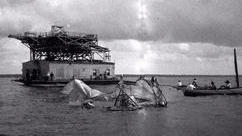
The Aerodrome's airframe incorporated several floats to prevent it
from sinking. It was a sodden mess, but easily retrieved.

Charles Manly waiting to be rescued.
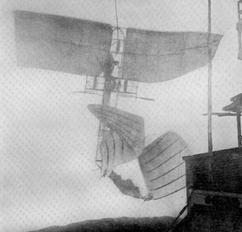
The Aerodrome just after it was launched on 8 December 1903.
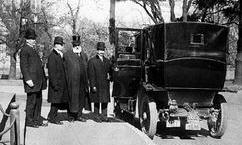
Left to right: Charles Walcott,
Wilbur Wright, Alexander Graham Bell and Orville Wright as they board
a limousine to take them to the presentation ceremony for the
Langley Medal.
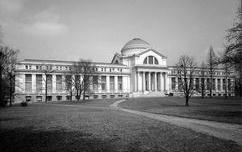
The new National Museum Building in 1911. It now serves as the
Smithsonian Museum of Natural History.
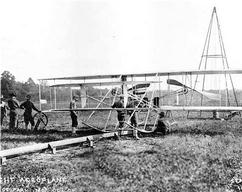
The 1909 Wright Miltary Flyer, designated "Signal Corps No. 1," was
retired and donated to the Smithsonian Institution in 1911. It
presently hangs in the Smithsonian Air & Space Museum.
|